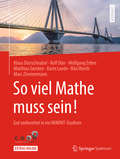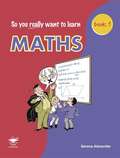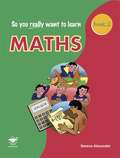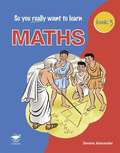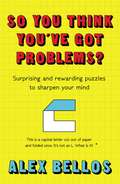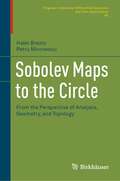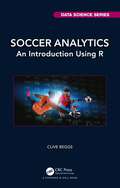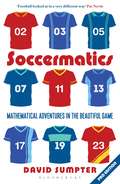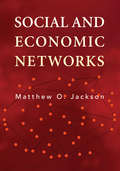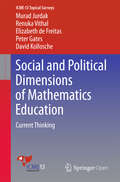- Table View
- List View
So viel Mathe muss sein!: Gut vorbereitet in ein WiMINT-Studium
by Marc Zimmermann Rita Wurth Karin Lunde Matthias Gercken Wolfgang Erben Rolf Dürr Klaus DürrschnabelMithilfe dieses Arbeitsbuchs wird der Leser auf die mathematischen Herausforderungen in einem WiMINT-Studium vorbereitet. Kurze, verständlich formulierte Texte frischen Schulwissen wie logisches Begründen, Bruchrechnen, Differenzialrechnung oder lineare Gleichungssysteme wieder auf. Hierbei helfen eine Vielzahl an Beispielen und Aufgaben mit Lösungen sowie Selbsttests am Anfang jedes Kapitels, mögliche Stolperfallen schon frühzeitig zu identifizieren. Thematisch orientiert sich das Arbeitsbuch am sogenannten cosh-Mindestanforderungskatalog, welcher von Lehrenden aus Schule und Hochschule gemeinsam entwickelt wurde. Dieser hält nach übereinstimmender Meinung vieler deutscher Hochschulen, Dachverbände und Dozenten das für ein WiMINT-Studium notwendige mathematische Vorwissen fest. Neben allgemeinen mathematischen Kompetenzen werden elementare Algebra, Geometrie, Analysis, lineare Algebra und analytische Geometrie abgedeckt.
So You Really Want to Learn Maths: Book 1 (PDF)
by Serena AlexanderFollowing the changes to the CE syllabus, Serena Alexander has written a brand new Maths course for use in prep schools. The course is in three parts, with each part seeking to revise, consolidate and extend so that two or three National Curriculum levels are covered on each topic.
So You Really Want to Learn Maths: Book 2 (PDF)
by Serena AlexanderBook 2 completes the course for Common Entrance Papers 1 and 3. Each chapter has an extension exercise designed to stretch potential scholars and finishes with a mixed exercise for revision. The book is suitable for Years 7/8.
So You Really Want to Learn Maths: Book 3 (PDF)
by Serena AlexanderBook 3 is suitable for more able pupils. It revises the work in Book 2, covers the extra topics required for Common Entrance Papers 2 and 4, and provides the ideal course for those preparing for scholarship exams at 13+. The book is suitable for Years 7/8.
So You Think You've Got Problems?: Surprising and rewarding puzzles to sharpen your mind
by Alex BellosSo you think you've got problems? In this book, you will be:Imprisoned by a sadistic logician.Challenged to raise dogs from the dead. Trapped on a burning island.And much more besides . . .Everything is at stake in this compendium of more than 150 ingenious puzzles, selected to reveal the wonderful diversity of brainteasers that have confounded and intrigued solvers for the last thousand years. You'll need to pit your wits against probability problems, wrestle with wordplay, grapple with geometry and scrabble for survival. Along the way you will discover stories of whip-smart thinkers, eccentric novelists and a poodle with allegedly supernatural powers. You will absorb fascinating and important mathematical ideas. Some solutions will rely on ingenuity, some will challenge you to spot hidden patterns, others call for extreme rationality. All will surprise, entertain and stretch your brain. Will you make it out with your puzzling pride intact?
Sobolev Gradients and Differential Equations (Lecture Notes in Mathematics #1670)
by john neubergerA Sobolev gradient of a real-valued functional on a Hilbert space is a gradient of that functional taken relative to an underlying Sobolev norm. This book shows how descent methods using such gradients allow a unified treatment of a wide variety of problems in differential equations. For discrete versions of partial differential equations, corresponding Sobolev gradients are seen to be vastly more efficient than ordinary gradients. In fact, descent methods with these gradients generally scale linearly with the number of grid points, in sharp contrast with the use of ordinary gradients. Aside from the first edition of this work, this is the only known account of Sobolev gradients in book form. Most of the applications in this book have emerged since the first edition was published some twelve years ago. What remains of the first edition has been extensively revised. There are a number of plots of results from calculations and a sample MatLab code is included for a simple problem. Those working through a fair portion of the material have in the past been able to use the theory on their own applications and also gain an appreciation of the possibility of a rather comprehensive point of view on the subject of partial differential equations.
Sobolev Gradients and Differential Equations (Lecture Notes in Mathematics #1670)
by john neubergerA Sobolev gradient of a real-valued functional is a gradient of that functional taken relative to the underlying Sobolev norm. This book shows how descent methods using such gradients allow a unified treatment of a wide variety of problems in differential equations. Equal emphasis is placed on numerical and theoretical matters. Several concrete applications are made to illustrate the method. These applications include (1) Ginzburg-Landau functionals of superconductivity, (2) problems of transonic flow in which type depends locally on nonlinearities, and (3) minimal surface problems. Sobolev gradient constructions rely on a study of orthogonal projections onto graphs of closed densely defined linear transformations from one Hilbert space to another. These developments use work of Weyl, von Neumann and Beurling.
Sobolev Maps to the Circle: From the Perspective of Analysis, Geometry, and Topology (Progress in Nonlinear Differential Equations and Their Applications #96)
by Haim Brezis Petru MironescuThe theory of real-valued Sobolev functions is a classical part of analysis and has a wide range of applications in pure and applied mathematics. By contrast, the study of manifold-valued Sobolev maps is relatively new. The incentive to explore these spaces arose in the last forty years from geometry and physics. This monograph is the first to provide a unified, comprehensive treatment of Sobolev maps to the circle, presenting numerous results obtained by the authors and others. Many surprising connections to other areas of mathematics are explored, including the Monge-Kantorovich theory in optimal transport, items in geometric measure theory, Fourier series, and non-local functionals occurring, for example, as denoising filters in image processing. Numerous digressions provide a glimpse of the theory of sphere-valued Sobolev maps. Each chapter focuses on a single topic and starts with a detailed overview, followed by the most significant results, and rather complete proofs. The “Complements and Open Problems” sections provide short introductions to various subsequent developments or related topics, and suggest newdirections of research. Historical perspectives and a comprehensive list of references close out each chapter. Topics covered include lifting, point and line singularities, minimal connections and minimal surfaces, uniqueness spaces, factorization, density, Dirichlet problems, trace theory, and gap phenomena.Sobolev Maps to the Circle will appeal to mathematicians working in various areas, such as nonlinear analysis, PDEs, geometric analysis, minimal surfaces, optimal transport, and topology. It will also be of interest to physicists working on liquid crystals and the Ginzburg-Landau theory of superconductors.
Sobolev Spaces (Springer Series in Soviet Mathematics)
by Vladimir Maz'yaThe Sobolev spaces, i. e. the classes of functions with derivatives in L , occupy p an outstanding place in analysis. During the last two decades a substantial contribution to the study of these spaces has been made; so now solutions to many important problems connected with them are known. In the present monograph we consider various aspects of Sobolev space theory. Attention is paid mainly to the so called imbedding theorems. Such theorems, originally established by S. L. Sobolev in the 1930s, proved to be a useful tool in functional analysis and in the theory of linear and nonlinear par tial differential equations. We list some questions considered in this book. 1. What are the requirements on the measure f1, for the inequality q
Sobolev Spaces: with Applications to Elliptic Partial Differential Equations (Grundlehren der mathematischen Wissenschaften #342)
by Vladimir Maz'yaSobolev spaces play an outstanding role in modern analysis, in particular, in the theory of partial differential equations and its applications in mathematical physics. They form an indispensable tool in approximation theory, spectral theory, differential geometry etc. The theory of these spaces is of interest in itself being a beautiful domain of mathematics. The present volume includes basics on Sobolev spaces, approximation and extension theorems, embedding and compactness theorems, their relations with isoperimetric and isocapacitary inequalities, capacities with applications to spectral theory of elliptic differential operators as well as pointwise inequalities for derivatives. The selection of topics is mainly influenced by the author’s involvement in their study, a considerable part of the text is a report on his work in the field. Part of this volume first appeared in German as three booklets of Teubner-Texte zur Mathematik (1979, 1980). In the Springer volume “Sobolev Spaces”, published in English in 1985, the material was expanded and revised. The present 2nd edition is enhanced by many recent results and it includes new applications to linear and nonlinear partial differential equations. New historical comments, five new chapters and a significantly augmented list of references aim to create a broader and modern view of the area.
Sobolev Spaces in Mathematics I: Sobolev Type Inequalities (International Mathematical Series #8)
by Vladimir Maz'YaSobolev Spaces in Mathematics II: Applications in Analysis and Partial Differential Equations (International Mathematical Series #9)
by Vladimir Maz'YaSobolev spaces become the established and universal language of partial differential equations and mathematical analysis. Among a huge variety of problems where Sobolev spaces are used, the following important topics are the focus of this volume: boundary value problems in domains with singularities, higher order partial differential equations, local polynomial approximations, inequalities in Sobolev-Lorentz spaces, function spaces in cellular domains, the spectrum of a Schrodinger operator with negative potential and other spectral problems, criteria for the complete integration of systems of differential equations with applications to differential geometry, some aspects of differential forms on Riemannian manifolds related to Sobolev inequalities, Brownian motion on a Cartan-Hadamard manifold, etc. Two short biographical articles on the works of Sobolev in the 1930s and the foundation of Akademgorodok in Siberia, supplied with unique archive photos of S. Sobolev are included.
Sobolev Spaces in Mathematics III: Applications in Mathematical Physics (International Mathematical Series #10)
by Victor IsakovSobolev Spaces on Riemannian Manifolds (Lecture Notes in Mathematics #1635)
by Emmanuel HebeySeveral books deal with Sobolev spaces on open subsets of R (n), but none yet with Sobolev spaces on Riemannian manifolds, despite the fact that the theory of Sobolev spaces on Riemannian manifolds already goes back about 20 years. The book of Emmanuel Hebey will fill this gap, and become a necessary reading for all using Sobolev spaces on Riemannian manifolds.Hebey's presentation is very detailed, and includes the most recent developments due mainly to the author himself and to Hebey-Vaugon. He makes numerous things more precise, and discusses the hypotheses to test whether they can be weakened, and also presents new results.
Sobolev Spaces, Their Generalizations and Elliptic Problems in Smooth and Lipschitz Domains (Springer Monographs in Mathematics)
by Mikhail S. AgranovichThis book, which is based on several courses of lectures given by the author at the Independent University of Moscow, is devoted to Sobolev-type spaces and boundary value problems for linear elliptic partial differential equations. Its main focus is on problems in non-smooth (Lipschitz) domains for strongly elliptic systems.The author, who is a prominent expert in the theory of linear partial differential equations, spectral theory and pseudodifferential operators, has included his own very recent findings in the present book.The book is well suited as a modern graduate textbook, utilizing a thorough and clear format that strikes a good balance between the choice of material and the style of exposition. It can be used both as an introduction to recent advances in elliptic equations and boundary value problems and as a valuable survey and reference work. It also includes a good deal of new and extremely useful material not available in standard textbooks to date.Graduate and post-graduate students, as well as specialists working in the fields of partial differential equations, functional analysis, operator theory and mathematical physics will find this book particularly valuable.
Soccer Analytics: An Introduction Using R (Chapman & Hall/CRC Data Science Series)
by Clive BeggsSports analytics is on the rise, with top soccer clubs, bookmakers, and broadcasters all employing statisticians and data scientists to gain an edge over their competitors.Many popular books have been written exploring the mathematics of soccer. However, few supply details on how soccer data can be analysed in real-life. The book addresses this issue via a practical route one approach designed to show readers how to successfully tackle a range of soccer related problems using the easy-to-learn computer language R. Through a series of easy-to-follow examples, the book explains how R can be used to: Download and edit soccer data Produce graphics and statistics Predict match outcomes and final league positions Formulate betting strategies Rank teams Construct passing networks Assess match play Soccer Analytics: An Introduction Using R is a comprehensive introduction to soccer analytics aimed at all those interested in analysing soccer data, be they fans, gamblers, coaches, sports scientists, or data scientists and statisticians wishing to pursue a career in professional soccer. It aims to equip the reader with the knowledge and skills required to confidently analyse soccer data using R, all in a few easy lessons.
Soccer Analytics: An Introduction Using R (Chapman & Hall/CRC Data Science Series)
by Clive BeggsSports analytics is on the rise, with top soccer clubs, bookmakers, and broadcasters all employing statisticians and data scientists to gain an edge over their competitors.Many popular books have been written exploring the mathematics of soccer. However, few supply details on how soccer data can be analysed in real-life. The book addresses this issue via a practical route one approach designed to show readers how to successfully tackle a range of soccer related problems using the easy-to-learn computer language R. Through a series of easy-to-follow examples, the book explains how R can be used to: Download and edit soccer data Produce graphics and statistics Predict match outcomes and final league positions Formulate betting strategies Rank teams Construct passing networks Assess match play Soccer Analytics: An Introduction Using R is a comprehensive introduction to soccer analytics aimed at all those interested in analysing soccer data, be they fans, gamblers, coaches, sports scientists, or data scientists and statisticians wishing to pursue a career in professional soccer. It aims to equip the reader with the knowledge and skills required to confidently analyse soccer data using R, all in a few easy lessons.
Soccermatics: Mathematical Adventures in the Beautiful Game
by David Sumpter'Football looked at in a very different way' Pat Nevin, former Chelsea and Everton star and football media analystFootball – the most mathematical of sports. From shot statistics and league tables to the geometry of passing and managerial strategy, the modern game is filled with numbers, patterns and shapes. How do we make sense of them? The answer lies in the mathematical models applied in biology, physics and economics. Soccermatics brings football and mathematics together in a mind-bending synthesis, using numbers to help reveal the inner workings of the beautiful game.This new and expanded edition analyses the current big-name players and teams using mathematics, and meets the professionals working inside football who use numbers and statistics to boost performance.Welcome to the world of mathematical modelling, expressed brilliantly by David Sumpter through the prism of football. No matter who you follow – from your local non-league side to the big boys of the Premiership, La Liga, the Bundesliga, Serie A or the MLS – you'll be amazed at what mathematics has to teach us about the world's favourite sport.
Social Accounting for Industrial and Transition Economies (Routledge Revivals)
by Solomon CohenThis title was first published in 2002: Showing how the social accounting matrix provides a comprehensive framework for the analysis and tabulation of national statistics and how it can assist in developing economic policy, this work also demonstrates the key aspects of this approach in dealing with a wide range of economic and social issues. The reference, and the accompanying volume, "Social Accounting and Economic Modelling for Developing Countries" should be useful for researchers, instructors, policy makers and scholars.
Social Accounting for Industrial and Transition Economies (Routledge Revivals)
by Solomon CohenThis title was first published in 2002: Showing how the social accounting matrix provides a comprehensive framework for the analysis and tabulation of national statistics and how it can assist in developing economic policy, this work also demonstrates the key aspects of this approach in dealing with a wide range of economic and social issues. The reference, and the accompanying volume, "Social Accounting and Economic Modelling for Developing Countries" should be useful for researchers, instructors, policy makers and scholars.
Social and Economic Networks
by Matthew O. JacksonNetworks of relationships help determine the careers that people choose, the jobs they obtain, the products they buy, and how they vote. The many aspects of our lives that are governed by social networks make it critical to understand how they impact behavior, which network structures are likely to emerge in a society, and why we organize ourselves as we do. In Social and Economic Networks, Matthew Jackson offers a comprehensive introduction to social and economic networks, drawing on the latest findings in economics, sociology, computer science, physics, and mathematics. He provides empirical background on networks and the regularities that they exhibit, and discusses random graph-based models and strategic models of network formation. He helps readers to understand behavior in networked societies, with a detailed analysis of learning and diffusion in networks, decision making by individuals who are influenced by their social neighbors, game theory and markets on networks, and a host of related subjects. Jackson also describes the varied statistical and modeling techniques used to analyze social networks. Each chapter includes exercises to aid students in their analysis of how networks function. This book is an indispensable resource for students and researchers in economics, mathematics, physics, sociology, and business.
Social and Economic Networks in Cooperative Game Theory (Theory and Decision Library C #27)
by Marco Slikker Anne van den NouwelandSocial and Economic Networks in Cooperative Game Theory presents a coherent overview of theoretical literature that studies the influence and formation of networks in social and economic situations in which the relations between participants who are not included in a particular participant's network are not of consequence to this participant. The material is organized in two parts. In Part I the authors concentrate on the question how network structures affect economic outcomes. Part II of the book presents the formation of networks by agents who engage in a network-formation process to be able to realize the possible gains from cooperation.
Social and Economic Stimulating Development Strategies for China’s Ethnic Minority Areas
by Yanzhong Wang Sai DingThis book gathers the outcomes of various, extensive research efforts on building a moderately prosperous society in minority areas, which would allow China’s poor and poverty-stricken areas to comprehensively join the rest of society. Offering an essential reference guide, the book will help readers understand the process, achievements, problems, and future development with regard to building a moderately prosperous society in the new era.
Social and Political Dimensions of Mathematics Education: Current Thinking (ICME-13 Topical Surveys)
by Murad Jurdak Renuka Vithal Elizabeth de Freitas Peter Gates David KolloscheThis book examines the current thinking on five critical social and political areas in mathematics education. It focuses on material conditions in teaching and learning, and details features of social life and their influence on mathematics teaching, learning and achievement. Following an introduction, the first section addresses equitable access and participation in quality mathematics education. It explores this issue in different contexts and from different ideological perspectives. The second section traces the emergence and development of the notion of activism in mathematics education in theory, in the literature, in research and in practice. The third section then moves on to explore current research on the political forces at work in identity, subjectivity and (dis)ability within mathematics education, showing how emphasis on language and discourse provides information for this research, and how new directions are being pursued to address the diverse material conditions that shape learning experiences in mathematics education. Economic factors behind mathematics achievement form the topic of section four, which examines the political dimensions of mathematics education through the influence of national and global economic structures. The final section addresses distribution of power and cultural regimes of truth, based on the premise that although often deemed apolitical, mathematics and mathematics education are highly political institutions in our society. The book concludes with a summary and recommendations for the future.
